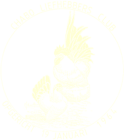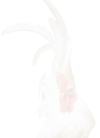|
|
|
|
 |
| |
| |
| The
little Chabo cock |
| in "the
Poultry Yard" by
Jan Steen |
| |
| -
continued - |
| |
|
|
|
|
|
In
the mean time Steen's little cock has
been described sufficiently.
Nevertheless the head-decorations of
this chicken from the seventeenth
century need some further attention,
because that way a better understanding
will come to the fore about its name of
variety. |
|
The
head-decoration of Steen's little cock
is most certainly, as can be clearly
seen, not a single comb, but rather a
papilionaceous crown comb. It is
inevitably, as can be seen in the
simulacra here above again, a totally
different comb than in the already
earlier mentioned drawing of the last
century. |
|
Also
therefore it is time now to look at Jan
Steen's painting closer to see what
other varieties of poultry breed scratch
around in that yard. |
|
We
will focus very first on another little
chicken right in the middle of all those
hens in the center of the painting that
verify its name. |
|
|
|
|
|
|
|
According
to some people this little chicken is a
hen of the same breed as the little cock
in Steen's painting. As a first
impression regarding the shape of the
body and the colour this seems to be
correct and also the place in the total
composition of the chickens - two cocks
dominant along the gathered hens in the
middle- as an internal repeated
triptych, as a repetition of the central
composition of the two men and the girl
being a shining center or the fair point
of attraction to which all the light
flows, gives rise to this opinion, but
there are many differences and not at
least of all it must also be doubted
whether this chicken, as it is depicted,
is really a hen. Anyway, this little
chicken does not show an intermediate
form of wattle, but a true beard and as
such it has all the appearance of a
(crested &) bearded bantam.
Also the other head-decorations are so
exuberant that they rather belong to a
cock than a hen. Besides it would
complete ideally and in fact the
composition of the poultry as a resumed,
but inversively composing repetition,
following the current ideas of those
days about sexual dimorphy. It would,
for that matter, also better agree with
the usual behaviour of poultry. |
|
|
|
|
 |
|
|
| |
|
|
|
The
fact that this bantam is fully bearded, the difference
with Steen's little cock, does not say of course that it
can not be a Chabo, but to be honest, there are too few characteristics
visible in the total appearance to conclude firmly so.
However, the head-decoration is of more interest now.
Again an intermediate form can be seen between the form
of a single comb and the form of a crown comb with (a
beginning of) a crest. This also gives all rise to the
supposition that this bantam too is not, as also Steen's
little cock is not, a pure bred Chabo according to
today's ideas concerned. A supposition that is supported
by the overwhelming presence of the many crested chicken
on the painting and the practice of the breeding of
bastards between Japanese bantams and crested poultry.
|
|
|
|
|
|
|
|
Some
of the bearded and crested poultry on the painting do
also show immense decoration feathers on their legs. The
fascination for exuberant feathering was apparently
quite a fashion in those days, as also is witnessed by
other paintings from that time of feathered beings by
Gijsbert and Melchior Hondecoeter.
|
|
It
cannot be said with certainty whether all animals
themselves enjoyed a great interest by Jan Steen for
their esthetical appearance. Also in his other
paintings the focus is, as is known, always on the
vividness of the scene. This piece is not an exeption.
The artistic Leitmotiv is rather 'movement' (and
of course the interest in feminine beauty) than just
poultry in the yard of a castle.
|
|
'click'
here to continue...
|
|
|
|
|
|
|
|
|
 |
|
| [click
the pictures concerned (or this link) for the
presentation of the painting, for reference] |
|
| [
Home page
>
the
C.L.C. > the
Chabo
>
the Chabo, Chabo's
in the Netherlands
> note
> (note)
continuation-1>
(note) continued-2
] |
|

|
|
|